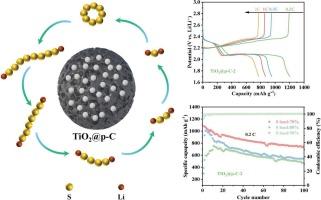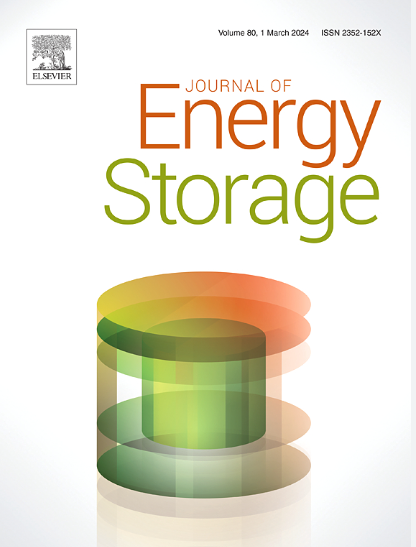Preparation of TiO2 nanoparticles decorated porous carbon via a pseudo co-templating strategy and their application as substrates for high performance cathode of LiS batteries
IF 8.9
2区 工程技术
Q1 ENERGY & FUELS
引用次数: 0
Abstract
Lithium‑sulfur batteries (LSBs) with a high theoretical specific capacity are considered as one of the most promising energy storage devices for next-generation. However, issues such as the insulation of pristine sulfur, the shuttle effect of polysulfides (LiPSs), and the volume change of sulfur cathode during cycling hinder their commercial applications. In this work, composite microspheres of TiO2@p-C consisting of porous carbon decorated with TiO2 nanoparticles, have been designed and synthesized aiming to confine and trap the polysulfides inside the porous substrates and to improve the kinetics of the electrochemical reaction therein. TiO2 particles with size of a few nanometers are prepared by a tetraethyl ammonium hydroxide assisted sol-gel method. Composite microspheres of TiO2@p-C are created through spray drying technique using chitosan as carbon source, and nanoparticles of SiO2 with TiO2 as co-template while selectively etching of the former. The confinement effects via the pores in the TiO2@p-C microspheres and the affinity between the polar TiO2 moieties and the polysulfide species work synergistically, alleviating the effusion of the polysulfides and promoting the conversion reaction of them as well. As a result, the shuttle effect of polysulfides can be inhibited obviously. Significantly, the S@TiO2@p-C-2 composite cathode exhibits excellent cyclic performance of 1263 mAh g−1 at 0.2C and maintains still a discharge capacity of 809 mAh g−1 after 100 charge and discharge cycles. At a current density of 2C, it still delivers an outstanding specific capacity of 772 mAh g−1. In the case of high sulfur load up to 90 wt%, the discharge capacity of S@TiO2@p-C-2 composite electrode could still maintain at 469.5 mAh g−1 after 100 cycles under current density of 0.2C.

通过伪共模板策略制备装饰多孔碳的 TiO2 纳米粒子,并将其用作高性能锂离子电池阴极的基板
具有高理论比容量的锂硫电池(LSB)被认为是下一代最有前途的储能设备之一。然而,原始硫的绝缘性、多硫化物(LiPSs)的穿梭效应以及硫阴极在循环过程中的体积变化等问题阻碍了它们的商业应用。本研究设计并合成了由多孔碳和 TiO2 纳米颗粒组成的 TiO2@p-C 复合微球,旨在将多硫化物限制和捕获在多孔基底内,并改善其中的电化学反应动力学。通过四乙基氢氧化铵辅助溶胶-凝胶法制备了几纳米大小的二氧化钛颗粒。以壳聚糖为碳源,通过喷雾干燥技术制备出 TiO2@p-C 复合微球;以 TiO2 为辅助模板,通过选择性蚀刻前者制备出 SiO2 纳米粒子。通过 TiO2@p-C 微球中的孔隙产生的约束效应以及极性 TiO2 分子与多硫化物之间的亲和力协同作用,缓解了多硫化物的渗出,同时也促进了它们的转化反应。因此,可以明显抑制多硫化物的穿梭效应。值得注意的是,S@TiO2@p-C-2 复合阴极在 0.2C 时具有 1263 mAh g-1 的优异循环性能,在 100 次充放电循环后仍能保持 809 mAh g-1 的放电容量。在电流密度为 2C 时,它仍能提供 772 mAh g-1 的出色比容量。在硫负荷高达 90 wt% 的情况下,S@TiO2@p-C-2 复合电极的放电容量在 0.2C 的电流密度下循环 100 次后仍能保持在 469.5 mAh g-1 的水平。
本文章由计算机程序翻译,如有差异,请以英文原文为准。
求助全文
约1分钟内获得全文
求助全文
来源期刊

Journal of energy storage
Energy-Renewable Energy, Sustainability and the Environment
CiteScore
11.80
自引率
24.50%
发文量
2262
审稿时长
69 days
期刊介绍:
Journal of energy storage focusses on all aspects of energy storage, in particular systems integration, electric grid integration, modelling and analysis, novel energy storage technologies, sizing and management strategies, business models for operation of storage systems and energy storage developments worldwide.
 求助内容:
求助内容: 应助结果提醒方式:
应助结果提醒方式:


